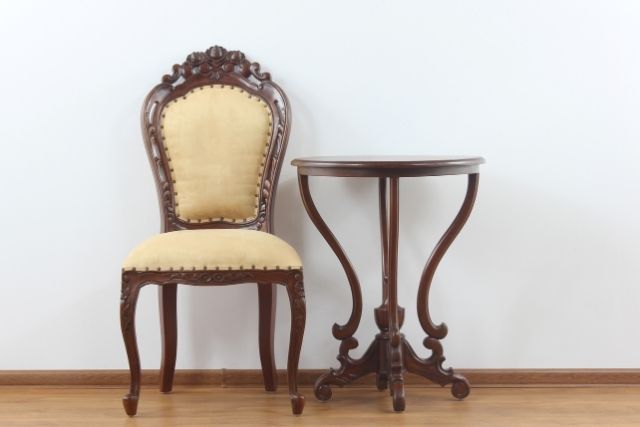How to Clean Antique Furniture Safely and Effectively: Expert Tips
Learning how to clean antique furniture effectively is crucial to preserving its beauty and integrity. Antique pieces can accumulate years of dust and pollution, making careful cleaning essential. In this guide, we will explore safe methods and gentle products, like mild dish soap and specialized polishes, to maintain and protect your valuable antiques without causing damage.

Cleaning Antique Furniture Properly
Pick a Gentle Cleaner
Start by picking a gentle cleaner. To avoid damaging antique furniture, avoid strong chemicals. A mild dish soap mixed with water is usually safe for cleaning antique furniture effectively. Make sure to use dish soap meant for hand washing, not the kind used in dishwashers, as it’s less harsh.
- If dish soap doesn’t remove the grime, you can use a slightly stronger cleaner like Murphy’s Oil, but only a little bit. Avoid using too much oily product on older furniture.
- Some experts recommend using furniture paste wax, available at most hardware or department stores, as a better choice for cleaning antiques than oil.
Gently Wiping Antique Furniture with a Soft Cloth and Cleaner
Begin by dampening a rag with a small amount of your chosen cleaner. Gently wipe the furniture’s surface. Continue using the same rag to wipe until it doesn’t pick up any more dirt or debris.
- Don’t scrub, as it can harm the finish of old furniture. Instead, use gentle wiping motions.
- Wipe the rag along the wood grain.
Removing Stubborn Stains from Antique Furniture with Steel Wool
Some spots might have tough stains or dirt. You can use very fine steel wool (#0000) to gently scrub these areas clean.
- Rub along the direction of the wood grain. Continue until all the dirt and debris are removed.
- Be careful not to rub too hard as it can damage the finish.
Cleaning Hard-to-Reach Areas of Antique Furniture with a Toothbrush
Some parts of the furniture, such as corners or curved areas, might be difficult to clean with a rag. For these spots, use a toothbrush. Dip it in your cleaning solution and scrub these hard-to-reach areas along the grain until they are free of dirt and grime.
Cleaning and Drying the Furniture
After cleaning, wipe the furniture with a dry cloth using gentle strokes to absorb most of the moisture until it feels dry. Let it air dry for a while before you continue cleaning.
Finish by Polishing the Furniture
After the furniture dries, apply a coat of polish to make it shine and look nice. To do this, use a clean cloth to buff the furniture until it glows. It’s best to avoid using silicone-based polishes on antiques.
Caring for Antique Furniture
Regular Dusting of Antique Furniture
To stop grime from building up, regularly dust your furniture. During your usual cleaning, use a cloth to wipe off any dust that has settled on your antique furniture.
- If you use dusting sprays, choose a gentle one or avoid using any spray on antiques.
Protect Antique Furniture from Sunlight
UV light can seriously damage antiques, so it’s best to keep them away from sunlight.
- Avoid leaving antiques outside, even in shaded areas.
- Keep antiques away from windows to protect them from outdoor sunlight.
Using a Humidifier in Dry Areas
Antique furniture can be damaged by changes in air moisture, causing the wood to shrink and crack. To protect your antiques, use a humidifier in the room where they are kept to maintain stable humidity levels and reduce damage from moisture changes.
Act Quickly to Remove Antique Furniture During a Pest Infestation
Antique furniture is valuable, so it’s important to protect it from pests. Bugs like beetles and rodents such as rats and mice can damage it. If you spot a pest infestation in your home, quickly move your antique furniture to a safe place until the infestation is cleared.
- Before moving antique furniture, check for any loose or damaged parts. Avoid carrying the furniture by any areas that are wobbly or detached.
- Carry chairs by the seat rails and tables by the apron or legs. When moving furniture, especially large pieces, always lift and carry it across the floor instead of dragging it.
Tips for Safe Cleaning and Maintenance
Seek Expert Advice Before Restoring Antique Furniture
If your antique is valuable or a collector’s item, don’t try to restore it yourself. Instead, consult a local antiques dealer for advice or consider hiring a professional if you’re not experienced in furniture restoration.
Test the Cleaner on a Small Area First
Before using a cleaner on your antiques, test it on a small, hidden part of the furniture, like under the chair seat. Apply a little cleaner, wait a few hours, and then check the spot. If there’s no damage or color change, the cleaner should be safe to use.
Don’t Use Oils on Very Old Furniture
Murphy’s Oil is generally safe for antiques if diluted. However, for very old wood furniture, it’s better to use wax-based cleaners instead of oil-based products. Wax not only cleans but also protects the wood.
Don’t Remove Paint from Furniture
You might see old or chipping paint on antique furniture and think about removing it. However, doing so can decrease the furniture’s value, so it’s best to leave the paint as it is.
- Collectors often prefer antiques to be as close to their original condition as possible, including any chipped or stained paint. If you plan to sell your antique furniture in the future, it’s particularly important not to change the paint.